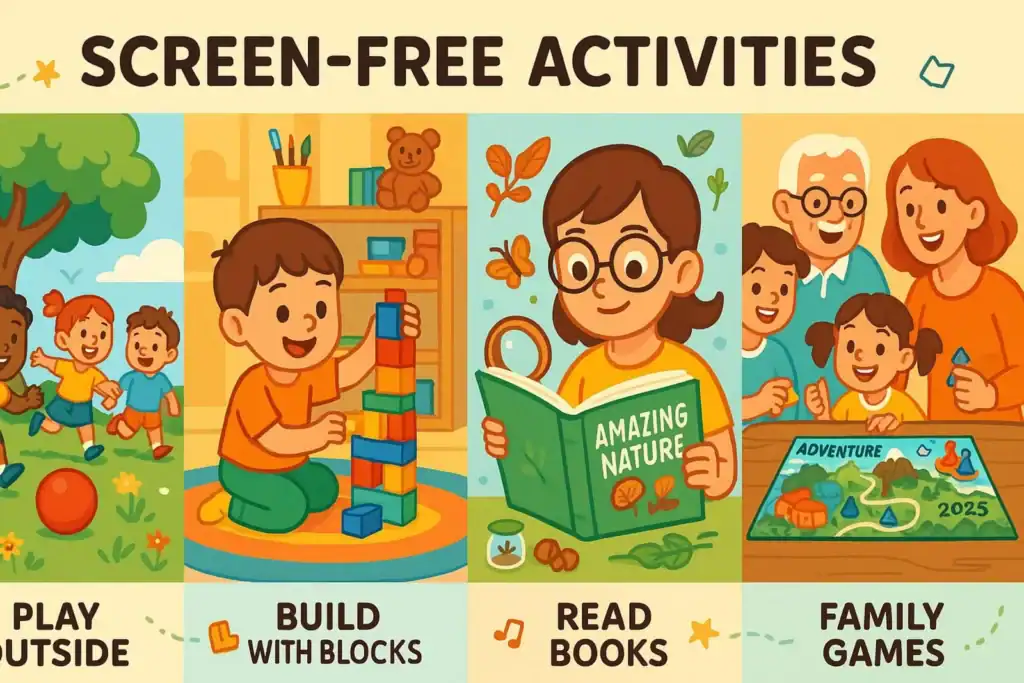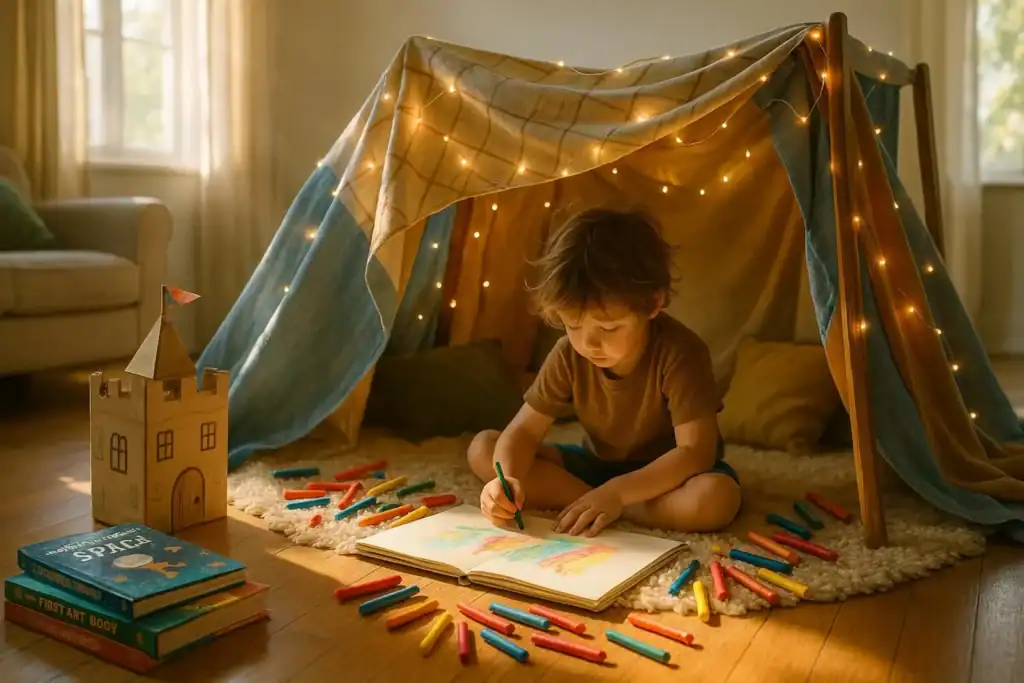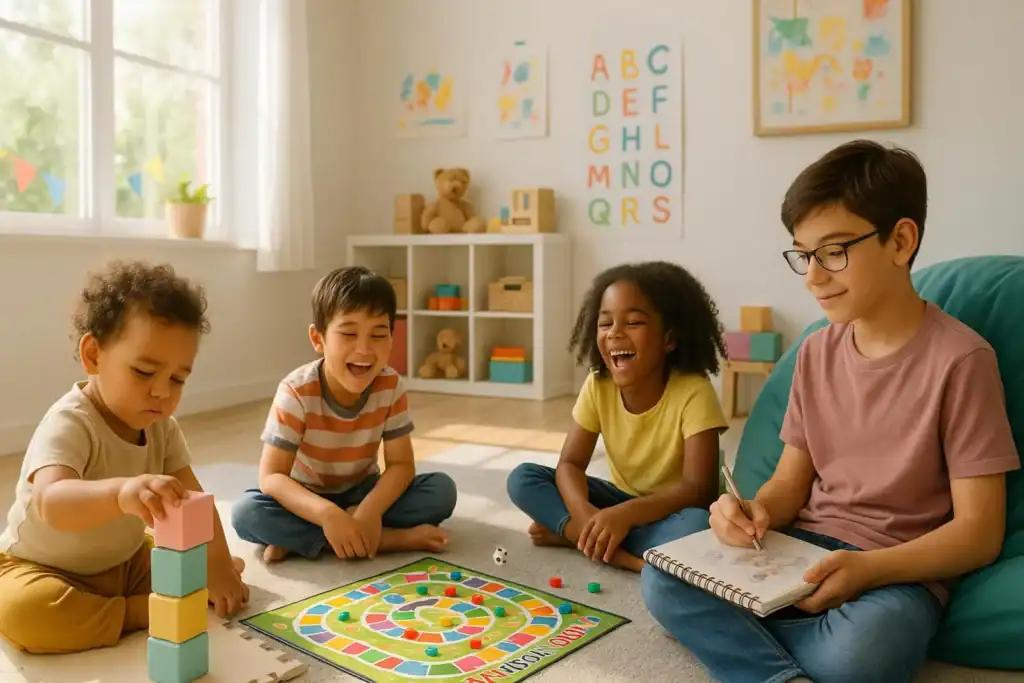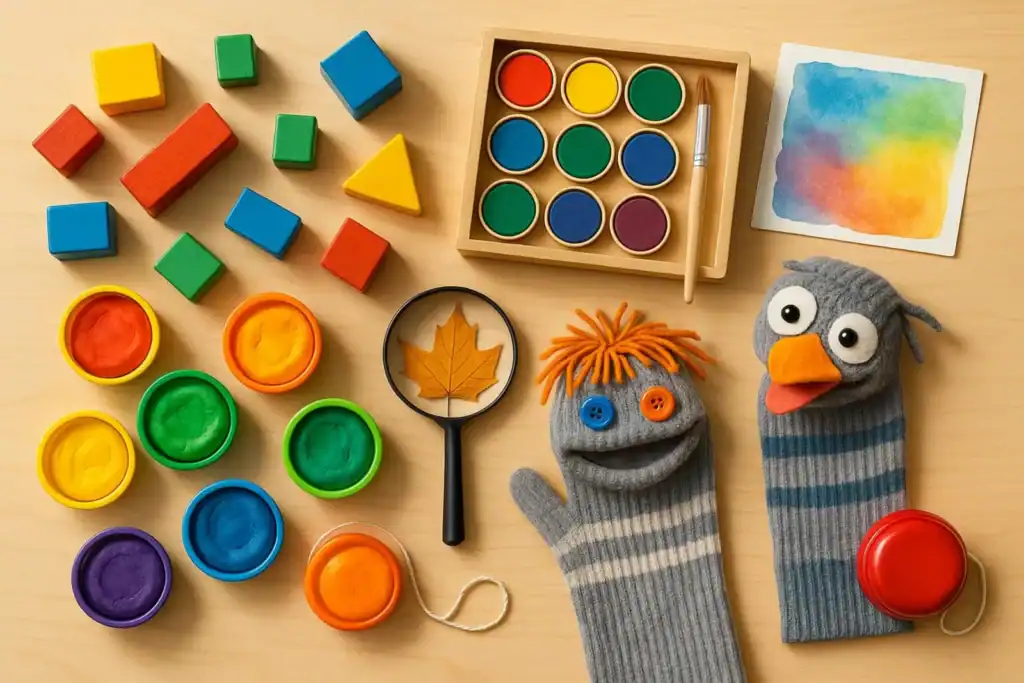Want to help kids of all ages step away from screens and enjoy real-life play? You can. Devices are everywhere, so giving children rich, screen-free options matters. This guide shares many ideas-active, creative, and calm-so every child can find something they enjoy. You’ll learn why these activities help, see age-by-age ideas, get toy and material tips, and find answers to common parent questions. The goal is a childhood full of imagination, connection, and hands-on experiences.
Why Choose Screen-Free Activities for Kids?
In a time when screens are the easy choice, pausing the online pull brings many direct benefits for kids. This isn’t about banning tech, but about a healthy balance that puts real play, movement, and face-to-face time first.
Heavy screen use can get in the way of growth. It can affect sleep, reduce movement, limit pretend play, and shorten focus. Choosing screen-free time helps kids follow their curiosity and build skills they need in daily life.
What Are the Benefits of Reducing Screen Time?
- Better physical health: more running, jumping, climbing, and better sleep.
- Stronger motor skills: active play builds balance, strength, and coordination.
- Longer attention span: puzzles, books, and building call for steady focus.
- Clearer thinking: problem-solving and planning happen during hands-on play.
- Mood support: quiet, screen-free time lowers stress and helps kids be present.
How Do Screen-Free Activities Support Child Development?
Open-ended play grows creativity. With art supplies, blocks, or make-believe games, kids imagine, test ideas, and solve problems. This kind of play builds independent thinking, an important skill for adult life.
Screen-free time also builds social and emotional skills. Board games, group projects, and pretend play teach talking, turn-taking, sharing, and empathy. Family time without screens-game nights, cooking, or gardening-brings people closer and creates memories that help kids feel safe and connected.
Types of Screen-Free Activities for Kids
Screen-free activities come in many forms, so you can find something that fits your child and your routine. Try a mix of outdoor movement and quiet creative time. You don’t need fancy supplies. Simple ideas often work best.
The goal is to spark curiosity, support independence, and make space for learning and real connection-no devices needed.

Active Outdoor Adventures
Fresh air and movement lift energy and mood. Go beyond a quick park visit. Try a nature walk and spot plants, birds, or bugs. Turn it into a scavenger hunt by finding certain colors, shapes, or leaves. On hot days, a hose and tarp can make a backyard slide that keeps kids laughing.
Casual sports build teamwork and coordination. Kick a ball, play catch, dribble a basketball, ride bikes, or set up a soft-ball dodgeball game. Make a simple obstacle course with household items. For younger kids, blowing bubbles never gets old.
Indoor Creative Play
On quiet days or rainy afternoons, art and crafts keep hands busy and minds calm. Try finger painting, paper crafts, DIY decorations, or coloring inside a large cardboard box with washable markers. Homemade slime or playdough offers a great hands-on feel for shaping and molding.
Building projects add challenge and fun. Use cardboard rolls and boxes to make a marble run, dollhouse, or castle. Make paper bag or sock puppets for a puppet show and storytelling. Build a blanket-and-pillow fort for reading, whispers, or daydreaming.

Educational and Learning Activities
Learning can be playful without screens. Reading grows vocabulary and attention. Let kids pick stories they enjoy, or read together before bed. Try simple science projects like a baking soda volcano or crystal growing to spark questions about how things work.
DIY learning kits help kids use real-life skills. Make a weather chart, count beans in jars for math, or create a family newspaper. Older kids can keep a science journal for notes and drawings. These ideas build observation, problem-solving, and real understanding.
Social and Group Games
Group games teach cooperation and patience. Classic board games (Snakes and Ladders, Ludo, Scrabble) build strategy and good sportsmanship. Card games make great family time. For younger kids, Simon Says and Mother May I build listening skills.
Plan playdates with fort-building, storytelling, or cooperative games. Try an indoor “snowball” fight with socks, or a pretend restaurant with menus and play food. Local events, fairs, and workshops help kids meet new friends and try new activities.
Chores That Encourage Responsibility
Chores teach life skills and teamwork. Present them as helpful jobs, not boring duties. Toddlers can match socks or “wash” low cabinets with a sponge and soapy water. Older kids can wash the car, bathe the dog, or help cook a meal.
Gardening is great for patience and care. Plant seeds, pull weeds, or make a bird feeder. Watching plants grow builds pride and a bond with nature. Kids learn they are capable and helpful at home.
Low-Energy Relaxation Ideas
Quiet time helps kids reset. Audiobooks let imaginations soar without screens. Drawing or painting lets feelings flow. Sitting in a box and coloring the inside can be surprisingly calming.
Older kids and teens can try journaling to sort thoughts and feelings. Simple breathing-inhale 4, hold 4, exhale 8-teaches self-calming. Make snow globes or calming jars with glycerin and glitter for a soothing craft. These moments support mental health and self-awareness.
Screen-Free Activities by Age Group
Children change fast, so activities should fit their stage and interests. Use this guide as a starting point, and switch ideas to fit your child. Many activities can be adjusted so siblings can join in together.
Offer choices that match attention span and skill level. This keeps screen-free time fun, successful, and relevant for each age.
| Age | Quick Ideas |
|---|---|
| Toddlers (1-3) | Water play; sensory bins; matching socks |
| Preschool (3-5) | Forts; puppets; simple obstacle course |
| Elementary (6-10) | Treasure hunt; DIY board game; craft kits |
| Tweens (11-13) | Music or art projects; cooking; bike wash |
| Teens (14+) | Garden project; language learning; community event |

Toddlers (Ages 1-3)
Toddlers learn by touching and moving. Try water play with ice cubes, cups, and floating toys in a baby tub. Rotate sensory bags or boxes weekly to keep textures fresh. For fine motor skills, poke pom-poms or pipe cleaners into egg carton holes, or thread cereal or pasta onto dry spaghetti stuck in clay.
Keep art simple: decorate a rock and make a “home” for it, draw a picture for a grandparent, or cut magazines with toddler scissors. Building ideas: drop balls through a hole in a box or clip clothespins on cardboard. Toddlers can “help” with chores like sock matching or wiping low cabinets. Always supervise and pick safe, sturdy items.
Preschoolers (Ages 3-5)
Preschoolers love make-believe and early teamwork. Build forts with blankets and pillows. Craft ideas: glue popsicle sticks into frames, cut and decorate a crown, or make sock or paper bag puppets for a show. Mix ivory soap, tissues, and water to make “clean clouds,” or paint the tub with a soap-cornstarch-food color mix for easy cleanup art.
For active play, make an obstacle course with yarn and tape, toss socks in an indoor “snowball” fight, or bowl with soda bottles. Make a painter’s tape spiderweb in a doorway and throw paper balls at it. Ask kids to list fun things they can do by themselves to grow independence. Simple cooking, like a peanut butter and banana sandwich, builds confidence.
Elementary Schoolers (Ages 6-10)
Kids this age enjoy projects with steps and a clear goal. Try a shoebox scene (ocean or jungle), paper dolls and outfits, or draw a puzzle on poster board and cut it out. Make slime or playdough, add buttons to an old T-shirt, or create “junk art” from old jewelry. Practice writing with a short story, joke book, letter to Grandma, or a journal.
Outdoor fun: plan a treasure hunt, fold and test paper airplanes, or dig waterways with a hose and PVC pipe. Design a board game or a backyard circus. Build life skills by organizing a room, making wrapping paper, or preparing lunch for the family.
Tweens and Middle Schoolers (Ages 11-13)
Kids are ready for self-expression and skill-building. Learn an instrument, write a song or poem, or build a small wood project. Make jewelry, tie-dye a shirt, or draw a comic. For science fans, keep a journal of experiments or set up a terrarium or aquarium.
Turn chores into learning: cook a favorite meal or make dinner for the family. Stay active with ping pong (even against a wall), rollerblading, or a neighborhood bike-and-vehicle wash. Try a daily act of kindness to grow empathy and awareness.
Teens (Ages 14+)
Teens benefit from challenges that match their interests. Plan an at-home Olympics, start a garden from scratch, or build a fort or treehouse. Learn a new language or read every book by a favorite author to grow focus and curiosity.
For social time, learn a card game and teach friends, or plan a small community event. For self-care, journal, practice deep breathing, or take a daily walk. Writing thank-you notes and keeping a gratitude list can support a positive outlook. Offer options that match their goals and give real ownership of their time.
Creative Screen-Free Toys and Materials for Kids
The right tools can spark long play. Look for open-ended items kids can use in many ways. Skip toys that do only one thing. Choose items that invite kids to build, move, imagine, and create-no batteries needed.
These choices support both solo and group play and help kids practice planning, patience, and problem-solving.

Toys Encouraging Outdoor Exploration
Pick items that get kids moving and noticing nature. A silicone flying disk like the Waboba Wingman flies straight and far (up to 40 meters) and folds flat for travel. A keepy-uppy ball turns coordination into a fun challenge. A Vortex Howler adds sound and sparks group play.
Simple tools work too: magnifying glasses, bug catchers, a small shovel and bucket. A camping projector that makes a night-sky effect and can switch into a campfire night light brings the outdoor theme inside for den-building or pretend camping. These tools invite kids to observe and explore.
Toys that Foster Creativity and Imagination
Choose flexible sets that let kids lead the play. One solar kit builds six moving models from recyclables while teaching about circuits and sun power. Another kit builds three robot rockets and explores basic circuits. A unicorn fairy garden lets kids plant, tend, and design a tiny world.
Load up on art supplies: paints, crayons, markers, paper, clay, and craft bits. Building toys like LEGO, magnetic tiles, and plain blocks help kids design anything they can dream. Puppets, dress-up clothes, and small figures support storytelling and role play.
Great Screen-Free Gift Ideas for All Ages
Pick gifts that support hands-on play. For little ones, try sensory bins with rice, pasta, or water beads plus scoops and cups. A quality stunt yoyo with lights and good bounce can grow coordination and patience for many ages.
For elementary kids, try a rock candy kit, a terrarium kit, or a craft set for snow globes or calming jars. Older kids may enjoy a journal with nice pens, a musical instrument, a big art set, or a classic board game with strategy. Books are always a solid choice. Match gifts to the child’s interests for lasting play and learning.
How to Make Family Routines More Screen-Free
Shifting family habits can feel hard in a screen-heavy world, but it’s doable with a clear plan and steady follow-through. You don’t have to cut screens out. Aim for balance so screens are a choice, not the default. Set clear rules, offer fun options, and involve everyone.
With a bit of planning, screen-free time can feel easy and fun. Build a home culture that values real-life experiences, talking, and growth over passive scrolling.
Suggestions for Families with Varying Ages
With kids of different ages, pick activities that scale up or down. On a nature walk, a toddler collects leaves, an elementary child listens for bird calls, and a teen takes photos. On game night, use games with simple rules or cooperative games so everyone plays.
Try family read-alouds with a chapter book. Make a group art piece like a mural or sculpture so each person adds their part. Cook together: toddlers stir, elementary kids measure, teens follow recipes and handle the stove. The aim is shared moments where everyone feels included.
Strategies to Replace Screen Time with Engaging Activities
- Create a go-to list of screen-free choices kids can pick from.
- Stock an “imagination corner” with art, building sets, puzzles, and books.
- Set screen-free places or times: dinner table, homework time, first hour after waking.
- Ask prompts: “What can you build?” “What can we do outside today?”
- Lead by example: put your own phone away during family time.
- Rotate toys and supplies often to keep interest high.
Getting Kids Excited about Screen-Free Time
Make it sound fun. Ask kids to help plan: “What new game should we try?” or “What craft do you want to make?” Use screen-free time as a special treat, not a penalty.
Make a “boredom jar” filled with activity slips they can draw from. Add surprises: a new art idea, a new park, an indoor “campout.” Praise effort and creations. When kids feel proud and in charge, they choose screen-free time more often.
Tips for Moving Away from Screens
Change takes time. Start small with one screen-free hour a day or one day a week, then extend it. Give clear warnings before screen time ends. Use visual timers or verbal countdowns.
If kids push back, name the feeling (“It’s hard to stop when it’s fun”) and offer a choice between two ready activities. Skip power struggles. Be consistent. Set the example by limiting your own screen use. Join in the play, be present, and celebrate small wins along the way.
Boosting Learning and Connection Without Screens
Screen-free play keeps kids active and alert. They solve problems, notice details, and talk with others. This kind of active time supports strong growth in school, friendships, and daily life.
When families set aside screen-free time, curiosity grows, creativity comes through, and relationships get stronger. You’re helping your child build resilience, empathy, and a love of learning.
Activities that Build Family Bonds
Shared fun brings families together. Game nights-board, card, or homemade-create laughs and teamwork. Cooking or baking invites everyone to help, from measuring to decorating. These moments teach skills and make sweet memories.
Go outside for a hike, picnic, or garden time. Make a family newspaper with stories, drawings, and jokes from each person. Read aloud to each other, share three things you’re thankful for, or plan a treasure hunt for a future outing. Small traditions add up to a strong family.
Ways to Help Kids Relax and Reflect
Teach simple ways to slow down. Older kids can journal to sort thoughts. Younger kids can “draw your feelings” with colors that match their mood. Audiobooks or calm music help minds wander without extra input.
Try short meditations for kids or the “five deep breaths” method to handle stress. Drawing, painting, or clay also helps express emotions. Quiet time in nature-watching clouds or sitting in a garden-supports calm and focus.
Supporting Social Development through Group Activities
Group play teaches key people skills. Plan playdates focused on building, games, or pretend play. Put on a short play with costumes and perform it for family. Make paper puppets and tell stories together.
Join community events like fairs, story hours, or workshops to meet new people. Volunteer as a family at an animal shelter or a neighborhood clean-up to build empathy and teamwork. Team sports, even casual ones, teach working toward a shared goal and reading social cues.
Addressing Parental Challenges and Common Questions
Starting a screen-free plan often raises questions. Parents worry about pushback, boredom, or where to begin. You’re not alone. Clear rules, honest talks, and steady habits help a lot. Be ready to adjust and keep going.
Answering common questions gives parents confidence to build routines that support kids’ health and growth. The aim is a plan that works for your whole family.
How Much Screen-Free Time Is Recommended for Kids?
There isn’t one perfect number. Many child experts say young kids need lots of hands-on time and very little screen time. For toddlers (1-3), keep screens near zero and focus on play with people. For preschoolers (3-5), about 1 hour a day of high-quality content is common when screens are used.
For elementary kids and tweens, keep screen use in check (often 1-2 hours for fun), making sure it doesn’t replace sleep, exercise, homework, or time with friends and family. For teens, guide responsible use and keep long stretches of screen-free time for mental health, school focus, and social life. The main goal: don’t let screens take over daily routines.
What If My Child Resists Screen-Free Activities?
Pushback is normal, especially if screens are part of the routine. Start by naming the feeling (“I see you don’t want to stop”). Offer a fun option right away. Keep a list of go-to activities and let your child choose: “LEGOs or outside with the ball?”
Be consistent. If protests lead to more screen time, kids learn it works. Set clear rules and stick to them. Cut your own screen time and join in play. Make screen-free time feel special. If needed, build up slowly and sit with your child at first, then step back as they get into it.
Are There Special Tips for Winter or Bad Weather?
- Set up an indoor obstacle course with pillows and furniture.
- Have a sock “snowball” fight or a hallway bowling lane with bottles.
- Put on music and dance; switch leaders every song.
- Work on big art: a mural on butcher paper or a room-size fort.
- Try science kits, puzzles, or board games.
- Do family read-alouds or listen to audiobooks together.
Keep an “indoor activity kit” ready and enjoy the cozy feel of home days.
Resources and Recommended Reads for Screen-Free Parenting
Learning about screen-free parenting is ongoing, and many helpful resources can guide you. From books to online groups, you can find ideas, support, and new activities that fit your family. These tools can keep you motivated and make daily choices easier.
You’re part of a growing group of parents who put real-life play and connection first. The ideas below can help you keep going.
Books and Podcasts to Inspire Screen-Free Living
For practical tips, try Dr. Laura Markham’s “Peaceful Parent, Happy Kids.” It focuses on kindness, connection, and clear guidance parents can use right away. Many families find her advice makes home life calmer.
Podcasts are an easy audio option for busy parents. Search for shows on child development, positive parenting, and screen-free activities. Lists like “Screen-Free Summer: Top Podcasts for Kids and Families” point to kid-friendly listening. Play episodes during commutes, chores, or walks-no screen needed.
Websites and Support for Screen-Free Ideas
Ironically, the internet can help you go screen-free. Screen-Free.org shares activity logs, an annual booklist, how-to guides for screen-free time, and a blog with ideas. Common Sense Media rates content by age and offers timely advice for using media wisely. They post big lists of screen-free activities for different ages and seasons.
Sites like Thimble and Twig offer outdoor games, nature crafts, and creative play ideas. Many parenting blogs and education sites share regular lists sorted by age and play type. Dr. Laura Markham also sends free weekly tips to your inbox. Joining these communities brings steady ideas and support from other parents on the same path.







































